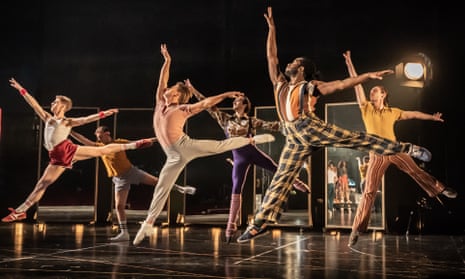‘I want it strong! Make it sharp! Take it on the downbeat and 5, 6, 7, 8!” A mass of laser-focused, high-kicking dancers move as if their lives depended on it – an epic battle royale, defeating their rivals round by round. Or an audition for a Broadway show, in other words. This one’s from A Chorus Line. It’s a musical with enduring appeal – Nikolai Foster’s acclaimed 2021 production goes on UK tour this summer.
A Chorus Line’s stories of performers struggling with troubled childhoods, sexuality, ageism, injury, breakdowns, poverty and thwarted ambition all came from real-life testimonies of Broadway dancers that director Michael Bennett recorded in late-night confessionals. The picture is one of an unforgiving career, but how true to life does the 1975 musical feel for dancers today?
“What’s real is that it’s a struggle,” says former West End dancer Terence Rodia, who now runs a management agency. “It’s a tough life, living from paycheck to paycheck, job to job.” But plenty of things do change, such as the trope of the heartless, sharp-tongued director, played in Richard Attenborough’s 1985 film version by Michael Douglas. “Nowadays we’re really trying to make the industry a better place,” says Rodia. “We’re trying to be kind to each other.”
Still, you can’t take the sting out of an audition. “I left college at 18 and I’m 37 this year, and it doesn’t get easier,” says Ashley Andrews, a British dancer based in New York and currently associate choreographer on the US and UK tours of Jesus Christ Superstar. “Walking into auditions, it’s truly like A Chorus Line: Love me! Give me a job! Am I enough? What more do you need from me?!”
In the film, hundreds of dancers line up down the block, but it’s rare these days to have open calls – where anyone can turn up and audition. Most auditions are invite only, via your agent, and the first round is often by self-tape.
“The hardest part is getting the audition in the first place,” says dancer Georgina Clarke, 24. There are more theatre schools now and more dancers, and competition is fierce. How on earth do you stand out? It’s not always having the best technique. Andrews often works with choreographer Drew McOnie, who, he says, is “totally driven by feeling and vibe; he wants electricity”.
A Chorus Line’s famous number Dance: 10, Looks: 3, about dancer Val getting plastic surgery (“Tits and ass / can change your life”), suggests how much looks matter. No one I speak to knows anyone who has had surgery, although Clarke had her teeth straightened after watching herself back on self-tapes so often. Natalie Chua, 31, who has been performing in the West End for 12 years (currently in Cabaret), says: “I think different bodies and people are a lot more celebrated now; it’s more inclusive.”

What about the cliche that dancers are constantly on a diet? “People would think it’s hilarious what we eat!” says Chua, listing the backstage snacks: doughnuts, bagels, sweets ... “In every job I’ve done, Fruit-tella has played a big part.” What about ageism? A Chorus Line’s Sheila is deemed over the hill at 30. “Now we have dancers who have children and go back on stage,” says Rodia. But you can’t stop time. “I was a much better dancer at 30 than I was at 21,” says Andrews. “But my body didn’t hurt at 21.”
Does every dancer have a tragic backstory like the ones we see in the musical? Not so much, although many are drawn to dance because “it’s a way of escaping, and letting out your emotions”, suggests Clarke. “Dancers have to be connected to their emotions, they have to be connected to their bodies,” says Andrews. “You have to be completely, completely vulnerable. That’s when you truly find yourself soaring.”
There are a lot of downsides to a dancer’s career: injuries, sacrifices, endless knockbacks. “I’ve got friends who’ve done a couple of West End shows and then they’re out of work for a year,” says Rodia. And there’s the money. Often dancers have done more training than anyone else on stage, and they’re being paid the least – although it depends where you are. On Broadway, says Andrews, someone in the ensemble of a long-running show might be on $2,700 (£2,200) a week, but on the equivalent show in London they’d be paid £700.
So why do it? At heart, A Chorus Line is about dance as vocation, and that’s as true as ever. “There are days where you’re like, I don’t know if my body can do this,” says Chua. “But the adrenaline rush, the community we have, being in front of the audience – you can’t beat it. It’s like a siren call.”

Comments (…)
Sign in or create your Guardian account to join the discussion